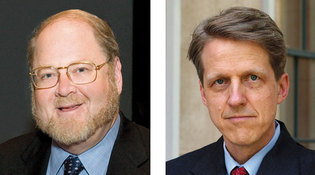 loading
loading
Light & VerityNobel Prizes for two Yale facultyAn economist and a biologist win the world's most prestigious prize.  Yale UniversityNobelists James Rothman '71 and Robert Shiller. View full image“It’s not every day that the Yale president is able to stand before the press and say ‘I’d like to introduce you to a Nobel laureate from Yale,’” President Peter Salovey ’86PhD said at an October 14 press conference. “It’s just every Monday.” Salovey, coming off a weekend of celebrating his inauguration, was there to mark that morning’s announcement that Sterling Professor of Economics Robert Shiller was one of three winners of this year’s Nobel Prize in Economics. The previous Monday, he had presided over a similar event honoring James Rothman ’71, a professor in the School of Medicine and one of three researchers who won the Nobel Prize in Physiology or Medicine. The two prizes doubled the ranks of Nobel laureates on the Yale faculty; Rothman and Shiller join Sterling Professors Sidney Altman and Thomas Steitz, who won prizes for chemistry in 1989 and 2009, respectively. Rothman, chair of the School of Medicine’s cell biology department, shares the prize for his part in solving “the mystery of how the cell organizes its transport system,” the Royal Swedish Academy of Sciences announced in October. It turns out there are three keys to the mystery: genes, location, and timing. Rothman, the Wallace Professor of Biomedical Sciences, is Mr. Location. “Each cell is a factory that produces and exports molecules”—insulin, for example, or neurotransmitters, the Nobel press release explained. “These molecules are transported around the cell in small packages called vesicles. The three Nobel laureates have discovered the molecular principles that govern how this cargo is delivered to the right place at the right time in the cell.” Randy Schekman, of the University of California at Berkeley, discovered the genes that control the transport system. Thomas Südhof, of Stanford, identified the mechanism by which the vesicles know exactly when to release their contents. And Rothman—who said at a Yale press conference on the day of the announcement that he’s been working on this puzzle for 25 years—“discovered that a protein complex enables vesicles to dock and fuse with their target membranes,” the press release said. “In the fusion process, proteins on the vesicles and target membranes bind to each other like the two sides of a zipper. The fact that there are many such proteins and that they bind only in specific combinations ensures that cargo is delivered to a precise location.” Rothman, 63, was a physics major as a Yale undergrad. After receiving his PhD in biochemistry at Harvard, he moved from Stanford to Sloan-Kettering to Columbia over his career before Yale lured him back in 2008 to do research at the university’s new West Campus. Three years ago, he shared the $1 million Kavli Prize in Neuroscience with Südhof and a third scientist, Richard Scheller. As it happened, the US government was shut down when the Nobel announcements were made, and federally funded scientific research had been halted. Rothman used the occasion to talk about a larger trend away from funding basic research. “I had five years of failure before the first initial success,” Rothman told Bloomberg News. “That kind of support—there’s less of it now. And that’s a pressing national issue.” The Nobel Prize in Economics, which Robert Shiller shares with Eugene Fama and Lars Peter Hansen of the University of Chicago, is “for their empirical analysis of asset prices”: why do stock prices jump around so much, and what sense can be made of them? Shiller’s contribution was to chart long-term trends in the ratio of prices to dividends. Over the decades, patterns of rising price-to-earnings ratios allowed Shiller to spot bubbles, including the dot-com and housing bubbles, that would surely burst. As you might guess from the title of his bestselling 2000 book, Irrational Exuberance, Shiller’s work in behavioral economics rejects the classical notion that markets and people behave along strictly rational lines. (For more on Shiller, see “They Called Him Mr. Bubble,” September/October 2009.) Shiller, 67, got his undergraduate degree at Michigan and his doctorate at MIT. He taught at Wharton and the University of Minnesota before coming to Yale in 1982. His study of the housing market led him and colleague Karl Case to create the Case-Shiller Home Price Index. At the press conference, Shiller explained his view that finance is not “a field about how to get rich.” Rather, it’s “the study of human activity at large. Just about any useful thing that we would like to get done involves groups of people”; financing provides resources and incentives to accomplish those useful things. “I was attracted to this department over 30 years ago,” Shiller said, “not just for the intellectual depth, but for the morality. It’s a matter of getting your real values integrated with your research.” “Rising inequality,” Shiller continued, is the most important problem facing the country and the world. “This is a problem that has solutions. Many of them are financial solutions. Finance is substantially about risk management. If it’s applied right, if it’s democratized—if the real tools are made useful to real people and not just the minority of people—it can help solve these problems.” Among Shiller’s own efforts at democratization are free online courses on financial markets: one available now through Open Yale Courses, and another beginning next year on Coursera.
The comment period has expired.
|
|